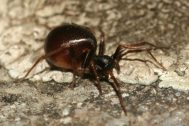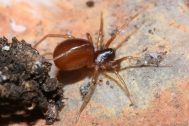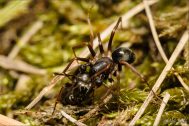| Nálezy podle období | |||||
|---|---|---|---|---|---|
| Zodariidae | 0-1900 | 1901-1950 | 1951-2000 | 2001+ | ∑ |
| Zodarion germanicum (C. L. Koch, 1837) Není ohrožený | 1× | 1× | 168× | 161× | 331× |
Zodarion germanicum (C. L. Koch, 1837)
| České jméno | mravčík obecný |
|---|---|
| Stupeň ohrožení | Není ohrožený |
| Nálezy | 331 nálezů, 77 kvadrátů |
| První nález |
1866, E. Bárta, Bárta 1869 |
| Poslední nález | 2025 , Tomáš Krejčí |
| Areál rozšíření | European - ME |
| Fytogeografická oblast |
|
| Původnost stanovišť |
|
| Vlhkost stanovišť |
|
| Stratum |
|
| Osvětlení stanovišť |
|
| Hojnost výskytu |
|
| Nadm. výška | 200-950 |
Literatura
Pavouci (Araneae) CHKO Brdy.
Spiders of the Brdy Protected Landscape Area were studied. Material obtained from pitfall traps exposed during the years 2016–2017 at 15 different representative localities included a total of 4027 individuals belonging to 154 species of spiders. Cold tolerant species (e.g. Bathyphantes similis and Pocadicnemis carpatica) as well as thermophilic species (e.g. Lathys humilis and Zodarion germanicum) were recorded. The West European species Palliduphantes ericaeus reaches here the easternmost border of its distribution, on the contrary the East European species Walckenaeria simplex has in this territory the western limit of its areal. A quarter of the recorded spider species is closely related to the original and natural habitats. Together with the published data and data from arachnological databases, the occurrence of 220 species of spiders is currently listed for the Brdy PLA, representing about 25 % of the total fauna of the Czech Republic. The results documented presence of interesting arachnofauna and confirm a high natural value of the given area.
Invertebrates of the Macocha Abyss (Moravian Karst, Czech Republic).
The invertebrates of the Macocha Abyss, Moravian Karst, Czech Republic, were collected in 2007–2008 and 222 species were identified in total. The relative abundance of individual taxa of land snails, harvestmen, pseudoscorpions, spiders, millipedes, centipedes, terrestrial isopods, beetles, and ants was evaluated. The cold-adapted mountain and subterranean species inhabit the bottom and lower part of the abyss, whereas the sun-exposed rocky margins were inhabited by thermophilous species. Macocha harbors several threatened species that are absent or very rare in the surrounding habitats. In the forest landscape, the Macocha Abyss represents a natural habitat with a distinct microclimatic gradient, and is an excellent refuge area for psychrophilous as well as thermophilous species, which significantly contributes to maintenance of landscape biodiversity.
Dietary and prey-capture adaptations by which Zodarion germanicum, an ant-eating spider (Araneae: Zodariidae), specialises on the Formicinae
Spiders on sandstone rocks in Central Europe with particular reference to the Bohemian Switzerland National Park.
While the majority of the Central European landscape would be covered by forests without human influence, rocky areas form isolated, islet-like, natural, non-forest habitats. The surface of some of these non-forested areas is composed of bare bedrock or products of its erosional breakdown (without a soil layer) such as gravel, sand banks, sand dunes, scree slopes and rock outcrop habitats. These habitats harbour specialized spider species that depend on their specific substratum and microclimate (Růžička 2000). Out of these habitats, rock walls (and scree slopes) form one of the most distinct ecological gradients of any terrestrial ecosystem (Larson et al. 1989, Růžička et al. 1995). They provide habitats with extremely warm and cold microclimatic conditions in close proximity. They also belong to habitats almost unknown until now due to the technical and practical problems of sampling.
Sandstones can form extensive systems of rocks, sometimes with a broad spectrum of meso- and microhabitats due to their very dynamic relief. Sandstone rocks are characterised by a marked contrast between forested plateau and bare vertical rock walls (Balatka and Sládek 1984). Upper margins of rocks are dry, vertical rock walls can be sun-exposed, dry and bare, or shady and humid and hence covered by mosses. Spaces with an extremely cold climate can occur in deep gorges. The aim of this study is to evaluate available data on the species composition of spider assemblages in sandstone rocks, including new data about spiders on rock walls in the Bohemian Switzerland (České Švýcarsko) National Park.
Fotografie
Statistiky
Dle měsíce v roce
Dle nadmořské výšky
Dle metody sběru (331 použitých nálezů)
| Zodarion germanicum (C. L. Koch, 1837) ES | Samci | Samice | Mláďata | Nálezy |
|---|---|---|---|---|
| Neurčeno | 86 | 21 | 0 | 72 |
| Individuální sběr | 17 | 17 | 5 | 32 |
| Zemní past | 562 | 217 | 649 | 218 |
| Prosev | 18 | 3 | 3 | 8 |
| Smyk | 1 | 0 | 0 | 1 |
| Samci | Samice | Mláďata | Nálezy |
Dle biotopu (331 použitých nálezů)
| Zodarion germanicum (C. L. Koch, 1837) ES | Samci | Samice | Mláďata | Nálezy |
|---|---|---|---|---|
| Neurčeno | 269 | 133 | 18 | 156 |
| Suťové a roklinové lesy | 6 | 3 | 0 | 4 |
| Kamenolomy | 29 | 8 | 0 | 10 |
| Lesostepní doubravy | 72 | 17 | 12 | 24 |
| Mokřady | 1 | 0 | 0 | 1 |
| Lužní lesy nížin | 2 | 0 | 0 | 2 |
| Dubohabřiny | 13 | 4 | 0 | 4 |
| Antropická společenstva | 0 | 1 | 0 | 1 |
| Suché doubravy | 27 | 9 | 4 | 20 |
| Skalní stepi na jiných horninách | 2 | 0 | 0 | 1 |
| Suché lesní lemy | 2 | 0 | 0 | 2 |
| Výsadby listnáčů | 56 | 11 | 0 | 3 |
| Suché křoviny | 4 | 0 | 0 | 3 |
| Reliktní bory na skalách | 6 | 2 | 0 | 4 |
| Skály a sutě v horách | 0 | 1 | 0 | 1 |
| Louky | 4 | 3 | 0 | 3 |
| Suché louky | 15 | 13 | 0 | 11 |
| Lesní okraje | 80 | 7 | 1 | 15 |
| Stinné skály nižších poloh | 6 | 4 | 3 | 8 |
| Okraje silnic | 41 | 14 | 5 | 3 |
| Bučiny nižších poloh | 1 | 0 | 0 | 1 |
| Kamenité suti nižších poloh | 9 | 6 | 2 | 12 |
| Skalní stepi na vápenci | 18 | 12 | 20 | 18 |
| Xerotermní travinobylinná společenstva | 3 | 4 | 3 | 4 |
| Porosty borůvek | 0 | 0 | 0 | 1 |
| Haldy a výsypky | 0 | 0 | 589 | 4 |
| Acidofilní bory | 1 | 0 | 0 | 1 |
| Paseky | 3 | 0 | 0 | 2 |
| Ruderály | 2 | 0 | 0 | 1 |
| Přirozené lesy | 1 | 0 | 0 | 1 |
| Výsadby jehličnanů | 3 | 4 | 0 | 5 |
| Rašelinné bory | 4 | 1 | 0 | 4 |
| Stojaté a pomalu tekoucí vody | 4 | 1 | 0 | 1 |
| Samci | Samice | Mláďata | Nálezy |
















